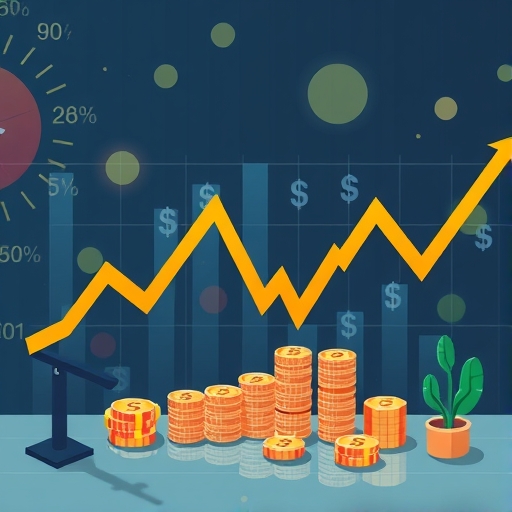Decoding Leveraged ETFs: Amplified Returns, Amplified Risks, and Strategic Trading
Have you ever wondered how some investment tools promise to multiply your market gains, offering 2x, 3x, or even 5x the daily returns of a particular index? Welcome to the intriguing, and often complex, world of **Leveraged Exchange-Traded Funds (LETFs)**. Unlike traditional Exchange-Traded Funds (ETFs) that aim to mirror an underlying asset’s performance one-for-one, LETFs are specialized financial instruments designed to amplify these daily movements. While the allure of magnified returns can be strong, we’ll quickly discover that leverage is a double-edged sword, dramatically increasing both potential profits and significant losses. In this comprehensive guide, we’ll demystify LETFs, exploring their intricate operational mechanics, the critical risks and costs involved, and ultimately, determine who stands to benefit from—or should outright avoid—including them in their investment toolkit.
Understanding these instruments is not just about potential gains but also about mitigating significant risks. Key aspects to grasp include their daily reset mechanism, the role of derivatives, and the implications of compounded returns over time. These elements collectively define the unique risk-reward profile of LETFs.
- Leveraged ETFs aim to multiply daily returns of an underlying index, often by 2x or 3x.
- They achieve this amplification through complex financial derivatives and borrowed capital.
- Unlike traditional ETFs, LETFs are designed for short-term trading due to their daily reset mechanism.

The landscape of financial products is constantly evolving, and understanding these sophisticated instruments is crucial for making informed decisions. We’ll break down complex concepts into digestible pieces, ensuring you grasp not just what LETFs are, but how they truly work, and why they demand a unique approach to investing.
What Are Leveraged ETFs and How Do They Magnify Market Moves?
At their core, **Leveraged ETFs (LETFs)** are a type of Exchange-Traded Fund that utilizes financial derivatives and borrowed capital to amplify the daily returns of an underlying index or asset. Imagine an index like the S&P 500 goes up by 1% in a single day. A traditional S&P 500 ETF would aim to return approximately 1%. However, a 2x leveraged S&P 500 ETF would seek to return 2%, and a 3x leveraged version would target 3% for that same day. This multiplier effect is what makes LETFs so distinct and, for some, so appealing.
These funds aren’t just for major indices; they can provide amplified exposure to a wide array of assets. You can find **LETFs** tracking popular benchmarks like the Nasdaq 100 and the Dow Jones Industrial Average, as well as specific sectors, single stocks, and even cryptocurrencies. For instance, the **Direxion Daily Financial Bull 3x Shares (FAS)** aims to deliver three times the daily performance of the Russell 1000 Financial Services Index, which includes major financial companies such as Berkshire Hathaway, Visa, and JPMorgan Chase & Co. This ability to target specific market segments with amplified exposure makes them versatile tools for short-term speculation.
To further clarify the types of leveraged ETFs, it’s helpful to understand the distinction between “bull” and “bear” funds, which are designed to capitalize on different market directions.
| Type of LETF | Market Expectation | Target Action | Example Index |
|---|---|---|---|
| Bull LETF | Rising Market | Amplify positive daily returns | S&P 500, Nasdaq 100 |
| Bear (Inverse) LETF | Falling Market | Amplify inverse daily returns | S&P 500, Nasdaq 100 |

The Inner Workings: Derivatives, Debt, and the Daily Reset Dilemma
Understanding *how* LETFs achieve their amplified returns is key to grasping their risks. They don’t simply buy more of the underlying stocks. Instead, **LETFs** employ a strategy known as “synthetic replication.” This involves a sophisticated blend of borrowing funds and using various **financial derivatives**. The most common derivatives you’ll encounter here include **futures contracts**, **forward contracts**, and **total return swaps**. Occasionally, **options contracts** might also be used. These instruments allow the fund to gain exposure to the price movements of an underlying asset without directly owning all of the assets themselves, making the process more capital-efficient for achieving leverage.
A closer look at the derivatives utilized reveals how these funds synthetically replicate market exposure without owning all underlying assets directly.
| Derivative Type | Primary Use in LETFs | Benefit for Leverage |
|---|---|---|
| Futures Contracts | Gain exposure to future price movements of an index/asset | High leverage potential with relatively low capital outlay |
| Forward Contracts | Customized agreements for future asset purchase/sale | Flexibility in tailoring exposure to specific needs |
| Total Return Swaps | Exchange of total return for a fixed/floating rate payment | Efficiently gain market exposure without owning the underlying asset |
| Options Contracts | Rights to buy/sell an asset at a set price | Can be used for hedging or targeted leveraged bets |
A critical feature that sets **LETFs** apart, and often leads to their complex behavior, is the **daily reset mechanism**. This means the fund rebalances its portfolio *every single day* to maintain its target leverage ratio. For example, if a 2x **LETF** tracks an index, it aims to deliver 2x the index’s return for that specific day, and then it “resets” for the next day. Why is this so important? Because over periods longer than a single day, the **LETF’s** returns can diverge significantly from simply multiplying the underlying index’s performance.
Let’s illustrate with a simple example:
Suppose an index starts at $100.
* **Day 1:** Index goes up 10% to $110. A 2x **LETF** goes up 20%. If it started at $100, it’s now $120.
* **Day 2:** Index goes down 10% from $110 to $99. That’s a -10% return.
* A traditional ETF would be at $99.
* The 2x **LETF**, which started Day 2 at $120, would go down 20% (2x -10%), losing $24. It ends the day at $96.
Notice that after two days, the index is down 1% (from $100 to $99). You might expect a 2x **LETF** to be down 2%. But our example shows it’s down 4% (from $100 to $96). This divergence is due to the daily reset and the effects of **compounding** returns, especially in volatile markets. What happens on Day 1 sets the base for Day 2’s calculation, and so on. This makes **LETFs** highly unpredictable for long-term holding periods, as the daily rebalancing can erode returns rapidly, particularly during periods of **market volatility** or sideways trading.

Navigating the Minefield: Risks, High Costs, and Regulatory Warnings
The magnifying power of **leverage** is indeed a **double-edged sword**. While it can amplify your gains, it equally magnifies your **losses**. This makes **LETFs** inherently high-risk investments, suitable only for investors with a high tolerance for risk and a deep understanding of their mechanics. The potential for substantial losses, particularly in volatile markets or during prolonged downturns, is a significant concern. The **daily reset mechanism**, as we just discussed, can also lead to **compounding losses** that are far greater than a simple multiple of the underlying index’s decline over longer periods.
Regulatory bodies are well aware of these risks. The **Securities and Exchange Commission (SEC)** in the United States, for example, has maintained continuous regulatory scrutiny over **LETFs** since their introduction in 2006. The SEC, along with market analysts, consistently issues strong warnings, emphasizing that **LETFs** are designed for **short-term trading strategies**, primarily for experienced **day traders** speculating on quick, significant market moves within an intraday period. They are explicitly warned against as **long-term investments** or for passive strategies, largely due to the unpredictable results caused by the daily rebalancing and compounding effects. Investors are strongly advised to thoroughly read the fund’s **prospectus** to understand the complex mechanics and risks involved before considering any investment.
Beyond the daily reset, several other factors contribute to the high-risk nature of these funds, making due diligence imperative for any potential investor.
- **Compounding Risk:** Returns over periods longer than a day diverge significantly from the target multiple.
- **Volatility Decay:** Sideways or highly volatile markets can rapidly erode value due to daily rebalancing.
- **Counterparty Risk:** Reliance on derivatives introduces risk related to the financial health of the derivative issuer.
Beyond the amplified risk, **LETFs** also typically incur higher **costs** compared to traditional ETFs. We’re talking about higher **management fees** and **transaction costs**. These elevated expenses stem from the complexity of managing a portfolio of sophisticated derivatives, the premiums associated with these derivatives, and the costs of borrowing funds (margin costs). While potentially less expensive than some direct margin trading, their typical **expense ratios** often exceed 1% annually. For example, average **expense ratios** in U.S. markets for **LETFs** often hover around 1.04%, while a specific fund like **FAS** might have an **expense ratio** of 0.94%. These higher costs can eat into your returns, further diminishing the long-term viability of **LETFs** for passive investors.

| Feature | Traditional ETF | Leveraged ETF (LETF) |
|---|---|---|
| Return Objective | 1x daily return of underlying asset | 2x, 3x, 5x daily return of underlying asset |
| Key Mechanism | Physical or synthetic replication | Synthetic replication (derivatives, debt) |
| Reset Frequency | Continuous tracking | Daily reset (rebalances daily) |
| Risk Profile | Moderate, tracks market | High, magnifies gains & losses |
| Long-Term Suitability | Generally suitable | Unsuitable (due to daily reset & compounding) |
| Typical Expense Ratio | ~0.05% – 0.50% | ~0.90% – 1.50%+ |
| Target Investor | Long-term, passive, diversified | Experienced, short-term, active trader |
Expanding the Horizon: Inverse and Single-Stock Leveraged ETFs
The world of **LETFs** isn’t limited to just amplifying positive market movements. There are also specialized variations designed to profit from bearish market sentiment or provide focused exposure to individual companies.
1. **Inverse Leveraged ETFs:** These funds are designed to generate positive returns when the underlying index or asset declines. If a market index drops by 1% in a day, an Inverse 2x **LETF** would aim to return +2% for that day. They essentially allow investors to take a “short” position with leverage, meaning they can profit from falling markets. This can be a strategy for **hedging** an existing portfolio against a short-term downturn or for pure **speculation** on market declines. An example is the **AXS TSLA Bear Daily ETF (TSLQ)**, which aims to provide inverse leveraged exposure to the daily performance of Tesla stock.
2. **Single-Stock Leveraged ETFs:** A newer and even more focused category, these funds provide amplified exposure (either leveraged or inverse leveraged) to the daily performance of individual, highly traded stocks. Imagine wanting 5x the daily return of a specific tech giant. Companies like Leverage Shares offer products that provide 5x leverage on various assets, including indices (like the U.S. 500), treasury bonds (e.g., 20+ Year Treasury Bond, TIPS), and even groups of popular stocks like the “Magnificent 7.” These products carry even greater concentration risk, as the performance hinges on a single company or a very narrow group of assets, amplifying both market-specific and company-specific risks.
These variations underscore the versatility, but also the escalating complexity and risk, within the **LETF** landscape. While they offer sophisticated tools for specific trading strategies, they demand even more diligent research and active monitoring.
Strategic Allocation: Who Should Trade (and Avoid) Leveraged ETFs
Given their intricate mechanics, high costs, and magnified risks, it becomes clear that **Leveraged ETFs** are not suitable for everyone. So, who exactly are these instruments designed for?
**Ideal Users:**
* **Experienced Day Traders:** Individuals who actively monitor market movements throughout the day and execute multiple trades to capitalize on short-term price fluctuations. They have a strong understanding of technical analysis and market dynamics.
* **Sophisticated Investors with Short-Term Strategies:** Those looking to make tactical, short-duration bets on market direction (e.g., anticipating a major economic announcement or a quick recovery).
* **Investors Seeking to Hedge:** Some professional traders might use **LETFs** for very short-term hedging strategies to offset potential losses in other parts of their portfolio during anticipated market downturns.
* **High-Risk Tolerance:** You must be comfortable with the possibility of losing a significant portion, or even all, of your investment very quickly.
**Who Should Avoid LETFs:**
* **Long-Term Investors:** If your goal is to save for retirement, a down payment, or other long-term objectives, **LETFs** are unequivocally unsuitable. The **daily reset mechanism** and **compounding losses** make them erode wealth over time rather than build it.
* **Passive Investors:** Those who prefer a “buy and hold” strategy and do not wish to actively monitor their investments will find **LETFs** detrimental to their portfolio.
* **Beginner Investors:** Without a deep understanding of derivatives, **leverage**, and **market volatility**, new investors are likely to incur significant losses.
* **Low-to-Moderate Risk Tolerance:** If the thought of losing 20-30% of your investment in a single day causes you stress, **LETFs** are definitively not for you.
To summarize the suitability of these complex instruments, consider the following investor profiles and their alignment with LETFs.
| Investor Profile | Risk Tolerance | Investment Horizon | LETF Suitability |
|---|---|---|---|
| Experienced Day Trader | Very High | Intraday/Short-term | Highly Suitable |
| Sophisticated Investor | High | Short-term tactical | Suitable for specific strategies |
| Long-Term Investor | Low to Moderate | Long-term (Years) | Unsuitable |
| Beginner Investor | Any | Any | Highly Unsuitable |
For those who do venture into this territory, active monitoring is paramount. Luckily, technology is stepping in to assist. **AI-powered tools** and investing apps like “Bobby” are emerging to help investors with **risk assessment**, provide real-time alerts on **market volatility**, offer **portfolio tracking**, and deliver essential **educational resources** regarding **LETFs**. Access to reliable **ETF data platforms** like Intrinio is also crucial for conducting thorough research and making informed decisions in such a fast-paced environment. These tools don’t eliminate the risk, but they can provide valuable support for highly engaged traders.
Conclusion: A Powerful Tool for the Prudent Few
**Leveraged ETFs** are undeniably powerful, sophisticated financial tools that offer the alluring prospect of **amplified returns** for those adept at navigating short-term **market fluctuations**. They provide a unique avenue for experienced **day traders** and astute investors to capitalize on quick, decisive market movements. However, their complex structure, elevated costs, and the critical impact of the **daily reset mechanism** mean they are far from a simple “ETF on steroids.” They demand a thorough understanding of their inherent **risks**, particularly the potential for **magnified losses** and the erosive effect of **compounding** over time, especially in volatile conditions.
We’ve seen that **LETFs** are emphatically unsuitable for **long-term investors** or those seeking passive growth. They are best reserved for disciplined, experienced traders capable of active market monitoring and who possess a high tolerance for risk. For the vast majority of investors, the stability, lower costs, and long-term growth potential of traditional **ETFs** remain the more prudent and effective pathway to achieving financial goals. Always remember, the financial markets reward knowledge and discipline, especially when dealing with instruments as potent as **Leveraged ETFs**.
Disclaimer: Investment in Leveraged ETFs involves significant risk, including the potential loss of principal. These products are complex and designed for short-term trading by experienced investors. Past performance is not indicative of future results. It is highly recommended to consult with a qualified financial advisor before making any investment decisions.
Frequently Asked Questions (FAQ)
Q: What is the primary difference between a traditional ETF and a Leveraged ETF?
A: A traditional ETF aims to replicate the daily performance of its underlying index one-for-one. A Leveraged ETF, however, uses derivatives and borrowed capital to amplify the daily returns, typically by 2x or 3x, of its underlying index.
Q: Why are Leveraged ETFs generally considered unsuitable for long-term investing?
A: Leveraged ETFs employ a daily reset mechanism, meaning they rebalance their portfolio every day to maintain their target leverage ratio. Over periods longer than a single day, the compounding effect of these daily resets, especially in volatile or sideways markets, can lead to significant divergence from the simple multiplied return of the underlying asset, often eroding returns or magnifying losses unexpectedly.
Q: Who is the ideal investor for a Leveraged ETF?
A: Leveraged ETFs are best suited for experienced day traders or sophisticated investors with a very high tolerance for risk. They are designed for short-term trading strategies to capitalize on quick, decisive market movements, not for long-term wealth accumulation or passive investing.



No responses yet